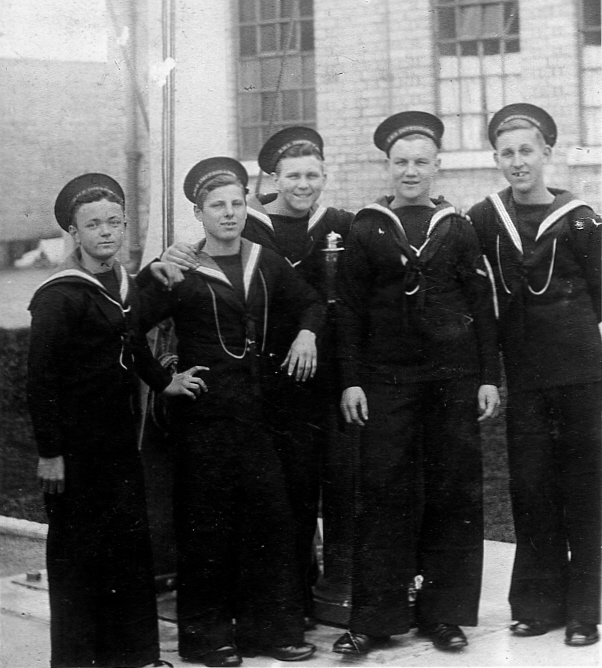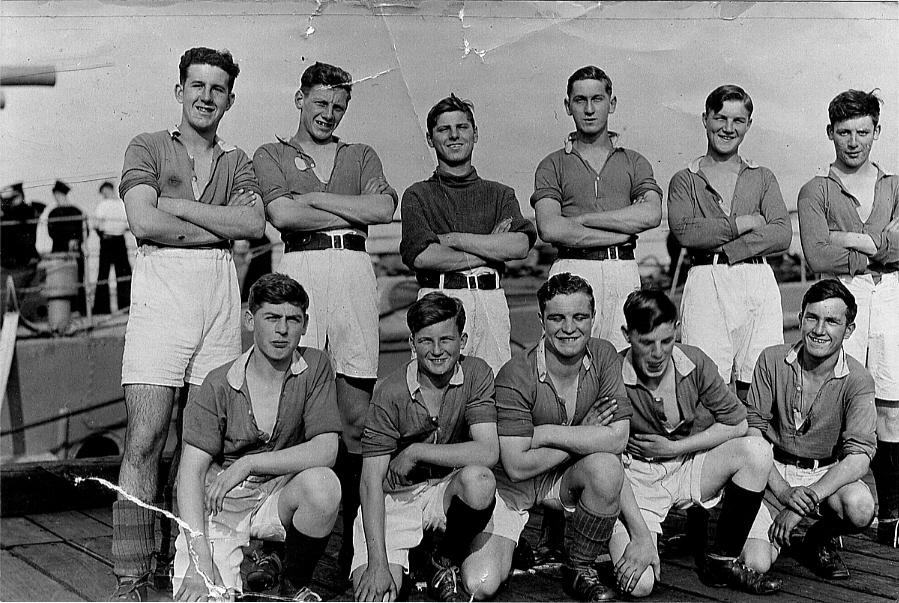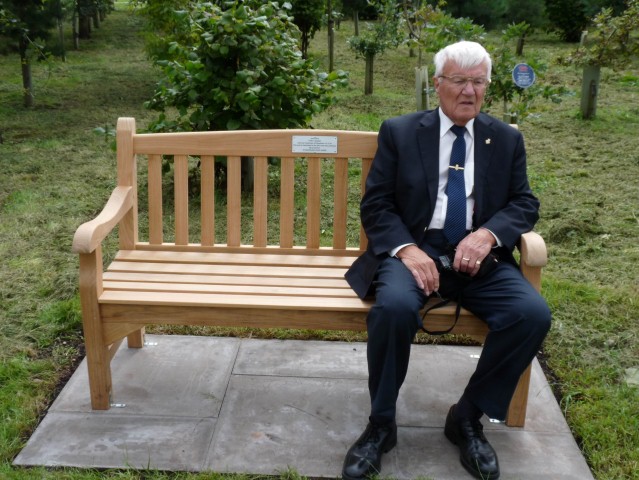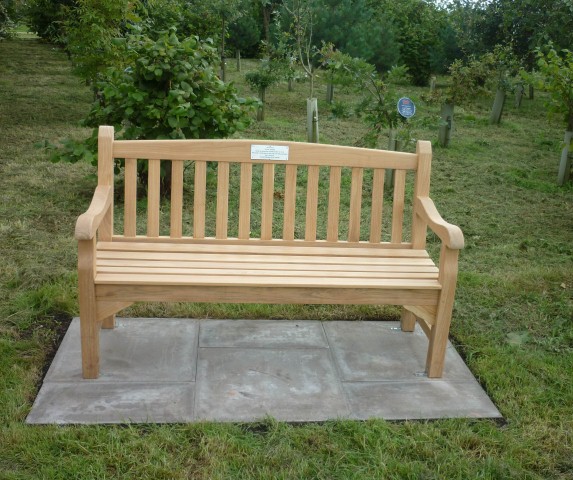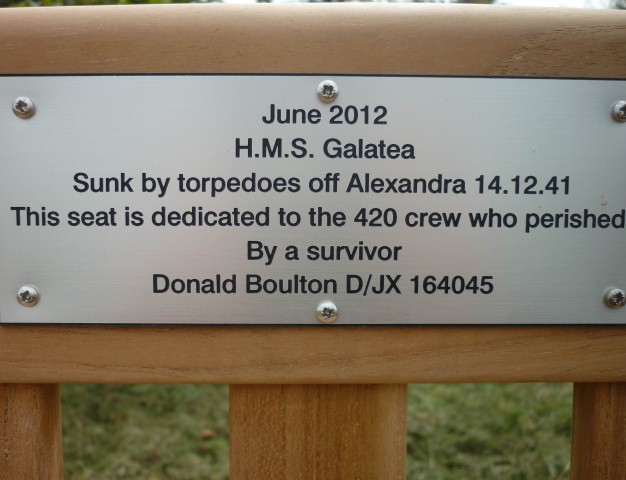I am now 84 years of age and a survivor of HMS Galatea. My story, however, starts on 18th September 1939. This will become obvious to the reader as the story progresses. On the above day at the age of 16, I joined HMS Impregnable, a boy-training establishment at St Beaux, Devonport. On this date a number of other boys also joined. We had all enlisted on a 22-year engagement. This term would commence when we attained 18 years of age. We were split into classes of 20. I have only one photograph of 5 boys at Impregnable; one of them though he would be unaware of it, subsequently saved my life. The photograph shows Frederick Hooper, Lesley Arberry, myself, one I cannot recall and Jack Binmore (who saved my life - I will explain later) Frederick Hooper and Lesley Arberry lost their lives on Galatea. The first week was spent kitting us out and learning how to sleep in hammocks. There were many crashes to the floor. There then followed very strict training until 17th July 1940 when a class of 20 boys were drafted to HMS Galatea, which we joined at Immingham.
With regard to the subsequent actions and movements made by Galatea, I have read a report a report on this web site which is basically correct except I have received, at considerable expense, the ship's log from the National Archives from the date we joined the ship. However, the ship's log for the months June and July 1941 is missing. I have received a letter from the Archives to this effect. It was during this period that the Galatea was escorting a convoy to Murmansk. If my memory serves me well, some of the contents of the convoy were Beaufighter planes. During the convoy we called at Seydisfjord to refuel. It was a very rough journey with thick ice over the ship. Whilst in Mermansk we could see flashes of gunfire at the Finnish border. While secured alongside we were at full readiness at all times, though we were allowed ashore, we were in the vicinity of the ship for recall if necessary.
We returned with another convoy to this country. Almost immediately, from the ice and winter clothing of the Russian convoy, we were detailed to escort a convoy to the Mediterranean via South Africa. Within a few days from the freezing Arctic, we were now in tropical gear. My abiding memory of this convoy was a merchant ship Polanski. She was continually making smoke, trying to keep up with the convoy. Many times we had to drop back to tell her to stop the smoke - an immediate signal to enemy aircraft or submarines. I believe we eventually had to leave her behind. We stopped at Capetown where we went ashore. I remember we were very grateful to the Salvation Army who arranged various trips for the crew. From there we went around the Cape to Durban where we were again allowed ashore. We continued with the convoy entering the Mediterranean and the Red Sea via the Suez Canal and being based at Alexandria. This now brings me to the fateful night of December 14th 1941.
We had been patrolling with two other cruisers and escort of 4 or 5 destroyers. During the day of the 14th, we were attacked continually mainly by Stuka dive-bombers and torpedo planes. By continually altering course we were able to avoid being hit but there were very near misses. It was a continual attack for 7 or 8 hours and only stopped when darkness came. We then made course to return to Alexandria. About 25 miles from the port there was a channel swept of mines. In order to enter this channel, the ships entered in line i.e. one behind the other. Galatea was the last in this line.
It was approaching midnight when the watches changed. At this time I had been sleeping in Y turret at the rear of the ship. It is at this point that Jack Binmore saved my life. He had been a lookout on the bridge but prior to the ship sailing, he had broken his arm and had been sent ashore. I had been given his watch as lookout and just before midnight, I left Y turret and was making my way to the bridge. I was amidships by the torpedo tubes when the three torpedoes struck. I was blown off the ship. By the time I recovered my senses I saw the bows of the ship go below the water. I was in the water for, about 6 hours covered in oil. At one stage I saw a hazel rod fender that looked high out of the water. For some time I struggled to get on it but had to give up as it kept rolling around and I kept going under it and swallowing more of the oily water. I just hung onto it for support.
I was eventually picked up by the destroyer HMS Griffin. It was a relief to get out of the oily water. The survivors were taken to Alexandria and after being medically checked over, we were placed in a transit camp. After a short time, much to the despair of those who were still in boy service, they were kept at Alexandria for drafting to other ships. It seems that in the Mediterranean, at this time on 21st March, I had been made an ordinary seaman and with other crew were returned to this country by convoy around South Africa. We were all aggrieved that those in the boys service had not been allowed home.
I have a photograph of the Galatea Boys Football Team taken at Immingham. I am unable to name all of them: left to right- Carol Kean, Lesley Arberry, Jack Binmore, Victor Deacon and Norman Darke and myself. The boys who joined the navy with me at Impregnable and who went down on Galatea are: Lesley Arberry, Norman Darke, Leonard Dawes, Victor Deacon, Frederick Hooper, Ronald Joiner, Carol Kean, William McCallister, Leonard Moore, Brendon Murphy, Keith Seddon and Bernard Wilkes.
I subsequently served on another cruiser HMS Bermuda from August 42 until July 44 as a petty officer, leaving the Navy March 1947 by purchase, joining the Gloucestershire Police Force and serving 30 years.


